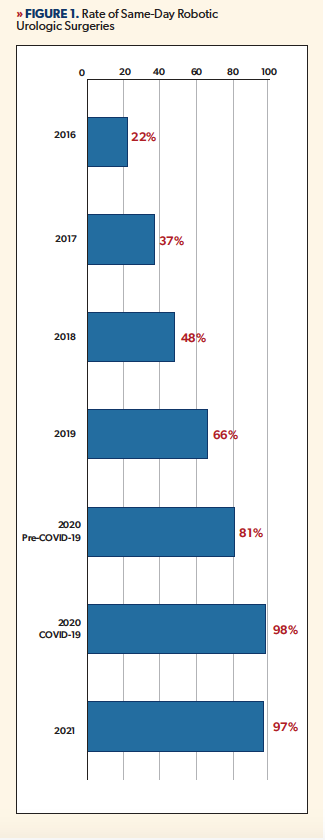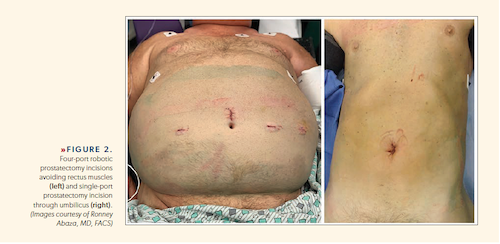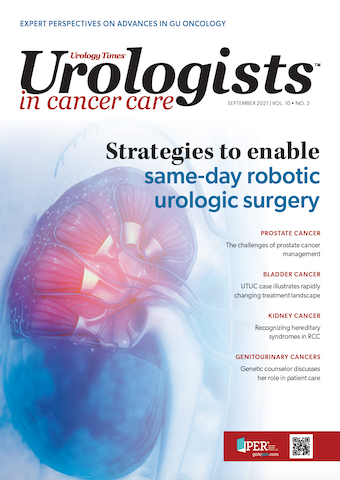Publication
Article
Urology Times Urologists in Cancer Care
Strategies to enable same-day robotic urologic surgery
Author(s):
Setting expectations and minimizing ports and drains are among steps to take.
Ronney Abaza, MD

Over the past 2 decades, robotic surgery has grown in urology to become the most common method for surgical management of prostate cancer and more recently for partial nephrectomy.1 Robotic surgery is also increasingly being applied to renal cancers requiring radical nephrectomy as well, even for complex and locally advanced tumors such as those invading contiguous organs or extending into the vena cava.2,3 Despite increasing adoption of robotic surgery and many advancements in technology and techniques over the past 20 years, the perioperative care of the robotic urologic surgery patient has not evolved as rapidly.
Within the past few years, some groups have explored the feasibility of taking advantage of the minimally invasive nature of robotic surgery to reduce hospitalization time postoperatively. This includes exploration of same-day discharge (SDD) after robotic prostatectomy, which nationally continues to have a mean length of stay of greater than 1 day, and the potential for overnight stay or even same-day robotic partial nephrectomy, which is still typically associated with a 2- to 3-night stay after surgery.4-7

We have endeavored to progressively reduce hospitalization time after robotic surgery and since 2016 have offered patients SDD after all types of robotic procedures other than cystectomy given the bowel used in diversions. In our first year of offering SDD, roughly 20% chose this option with gradual increases over time until now, when more than 95% of our robotic urologic surgery patients over the past 18 months were discharged within hours of their surgery with no increase in readmissions or emergency department (ED) visits (Figure 1).8 We have successfully instituted protocols for this at 3 different hospitals and most recently without residents, fellows, or advanced practice providers such that SDD is likely possible in most practice environments, although perhaps to differing degrees.
The delays in cancer surgery that resulted from the COVID-19 crisis during which nonemergent surgeries were prohibited in many states provide additional motivation to adopt SDD after robotic surgery given that this would allow continued surgical cancer care when the availability of hospital beds and inpatient staffing are strained. The following strategies are presented for enabling SDD, particularly by those more experienced surgeons who know their outcomes and have infrequent early complications that would require overnight stays.
Benefits of SDD
Because less than 1% of complications occur within the first 24 hours after robotic surgery, requiring overnight stays in all patients is more likely for reducing surgeon worry rather than benefiting patients. Most patients will prefer to recover in their homes, sleep in their own beds, eat home-cooked meals, and have their family around them rather than staying in a hospital as long as they know it is safe. Sleep has been shown to be important for recovery, but sleep disturbances experienced by patients on typical hospital wards have been shown to be worse than in an intensive care unit.9 Although challenging in the hospital often because of limited staffing, earlier ambulation is encouraged by SDD, which may reduce the risk of deep vein thrombosis and ileus. Lastly, in addition to saving hospital beds and staffing for other patients when hospital census is high, SDD reduces costs to hospitals given that they receive global payments for surgical encounters regardless of how long patients are hospitalized, and this may offset some of the additional costs of robotic surgery.4
Patient education
Setting expectations is critical to patients being comfortable with SDD. We introduce the expectation of SDD as long as everything goes as planned with surgery and anesthesia in the first patient encounter preoperatively and again in all printed educational materials, preoperative teaching by medical assistants, and by the surgeon in the preoperative area as well as with family postoperatively. Surgeons who have not attempted SDD before may be surprised by how often patients are pleasantly surprised that they will be allowed to go home on the same day as their surgery. Most patients either have experience with or know someone who has undergone outpatient surgery like laparoscopic cholecystectomy, hernia repair, or arthroscopy, and explaining that robotic surgery is very similar to these compared with traditional open surgery will help patients feel comfortable with SDD. Patients also need to know that if problems arise when they get home, they will have a safety net. Before surgery, we provide patients with a medical alert wallet card that has a phone number they can call 24 hours a day and instructs them to call before going to any ED with the opposite side having instructions (eg, catheter care) for other health care providers if they do end up in the ED or at an outside hospital.
Narcotic and drain avoidance
The benefits of narcotic avoidance include reduced ileus/constipation, confusion/sedation (especially in the elderly), nausea/vomiting, and risk of developing opioid addiction. We have successfully avoided intravenous narcotics in more than 5000 consecutive patients undergoing robotic surgery and allow oral narcotics but educate patients on the benefits of minimizing these. We routinely give ketorolac and place a belladonna and opium suppository before reversal of anesthesia and inject ropivacaine at all incision sites. Patients are discharged with 10 tablets of oral narcotic but instructed to use acetaminophen first and reserve narcotics for moderate to severe pain. Patients are told to medicate themselves with a goal pain score of 2 to 3 rather than 0 since it is normal to have some soreness after surgery, and injudicious amounts of narcotics would be needed to eliminate pain completely. More than half of our patients undergoing robotic surgery never end up using any narcotic tablets postoperatively. Additional options have been described for minimizing narcotics, and although we do not have experience with these, there may be benefits to using regional blocks (eg, transversus abdominis plane blocks), oral medications like gabapentin or celecoxib, intravenous lidocaine intraoperatively, or local injection of bupivacaine liposome injectable suspension.

Although some patients will not find home care of a drain to be a barrier to discharge, many patients will find this challenging particularly if also discharged with a bladder catheter (eg, prostatectomy). In addition, the presence of a drain will also reinforce the “sick role” in patients’ minds. Surgeons will also often default to overnight stay to allow drain removal prior to discharge because the vast majority of drains are used as a precaution and are removed the next day because no urine leak was present. Expert robotic surgeons should consider avoiding drains and evaluating their historical experience to determine whether they are necessary and can begin by selectively omitting drains when comfortable doing so and then transitioning to less and less use. We have performed more than 5000 robotic surgeries since adopting a routine of drain avoidance and used a drain in less than 1% of these patients even with known urinary tract violation, such as in prostatectomy, partial nephrectomy, nephroureterectomy, or ureteral reconstruction/pyeloplasty. In our experience, we would need to leave more than 600 drains to avoid 1 urine leak and more than 2000 drains to avoid each instance that required a percutaneous drainage procedure postoperatively.
Minimizing ports/incisions
Many robotic and laparoscopic surgeons have minimized the effect of each incremental port on patient perception and pain, but the recent interest in single-incision robotic surgery since the introduction of the da Vinci SP (single port) robot has called into question the suggestion that additional ports do not affect postoperative pain and recovery. In our experience, single-incision prostatectomy was associated with a 15% reduction in pain scores compared with traditional multiport prostatectomy.10 In particular, ports placed through the rectus muscle likely increase pain disproportionately because of pain with any abdominal contractions such as coughing, bending over, and sitting up. Surgeons should endeavor to use as few ports as possible to safely accomplish their operation. Even before the SP robot, we routinely used only 3 ports for nephrectomy, pyeloplasty, adrenalectomy, and ureteral reconstructions for over a decade given that almost all can be accomplished without an assistant port. Given our experience with SP surgery, we have more recently transitioned to a routine 4-port robotic prostatectomy without requiring an assistant port and eliminating any ports through the rectus (Figure 2).
Reduced pneumoperitoneum pressure
The insufflation pressures typically used for laparoscopic and robotic surgery of 12 or 15 mm Hg are based on tradition and are not supported by evidence. We adopted a routine of using 6 mm Hg for robotic pelvic surgery in 2016 and have performed more than 1500 consecutive procedures at this level. We previously identified a reduction in pain with prostatectomy performed at 6 mm Hg compared with our historical series at 15 mm Hg.11 We recently conducted a randomized comparison of prostatectomy at 15 mm Hg vs 6 mm Hg and found less mean and peak pain scores, less shoulder and groin pain, and faster return of bowel function at the lower pressure (unpublished data). We recommend that surgeons use the lowest pressure at which they are comfortable operating, as most will not find any difference operating at 6 mm Hg. Of note, we perform kidney and other upper tract surgery more often at 8 mm Hg given that the bowel can be more intrusive when not retracted by gravity in Trendelenburg position. Whether lower pressure has enough effect on pain or ventilation parameters to improve the rate of SDD is unknown, but we recommend this for surgeons adopting SDD because the potential benefit outweighs any liabilities.
The minimally invasive nature of robotic urologic surgery allows the adoption of SDD protocols. Surgeons can consider these strategies to enable this and begin to offer SDD to their patients with a gradual increase in the rate of SDD over time.
REFERENCES
1. Cheung H, Wang Y, Chang SL, Khandwala Y, Del Giudice F, Chung BI. Adoption of robot-assisted partial nephrectomies: a population-based analysis of U.S. Surgeons from 2004 to 2013. J Endourol. 2017;31(9):886-892. doi:10.1089/end.2017.0174
2. Jeong IG, Khandwala YS, Kim JH, et al. Association of robotic-assisted vs laparoscopic radical nephrectomy with perioperative outcomes and health care costs, 2003 to 2015. JAMA. 2017;318(16):1561-1568. doi:10.1001/jama.2017.14586
3. Petros FG, Angell JE, Abaza R. Outcomes of robotic nephrectomy including highest-complexity cases: largest series to date and literature review. Urology. 2015;85(6):1352-1358. doi:10.1016/j.urology.2014.11.063
4. Abaza R, Martinez O, Ferroni MC, Bsatee A, Gerhard RS. Same day discharge after robotic radical prostatectomy. J Urol. 2019;202(5):959-963. doi:10.1097/JU.0000000000000353
5. Abaza R, Shah K. A single overnight stay is possible for most patients undergoing robotic partial nephrectomy. Urology. 2013;81(2):301-306. doi:10.1016/j.urology.2012.08.067
6. Sentell KT, Badani KK, Paulucci DJ, et al. A single overnight stay after robotic partial nephrectomy does not increase complications. J Endourol. 2019;33(12):1003-1008. doi:10.1089/end.2019.0218
7. Mehrazin R, Bortnick E, Say R, Winoker JS. Ambulatory robotic-assisted partial nephrectomy: safety and feasibility study. Urology. 2020;143:137-141. doi:10.1016/j.urology.2020.04.111
8. Abaza R, Kogan P, Martinez O. Impact of the COVID-19 crisis on same-day discharge after robotic urologic surgery. Urology. 2021;149:40-45. doi:10.1016/j.urology.2021.01.012
9. Allen RW, Burney CP, Davis A, et al. Deep sleep and beeps: sleep quality improvement project in general surgery patients. J Am Coll Surg. 2021;232(6):882-888. doi:10.1016/j.jamcollsurg.2021.02.010
10. Abaza R, Murphy C, Bsatee A, Brown DH Jr, Martinez O. Single-port robotic surgery allows same-day discharge in majority of cases. Urology. 2021;148:159-165. doi:10.1016/j.urology.2020.08.092
Ferroni MC, Abaza R. Feasibility of robot-assisted prostatectomy performed at ultra-low pneumoperitoneum pressure of 6 mmHg and comparison of clinical outcomes vs standard pressure of 15 mmHg. BJU Int. 2019;124(2):308-313. doi:10.1111/bju.14682
About the author
Ronney Abaza, MD, FACS, is a urologist with Central Ohio Urology Group, Columbus.






















